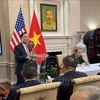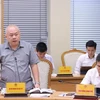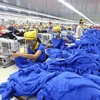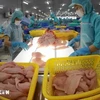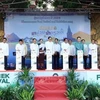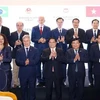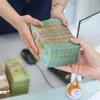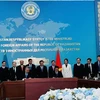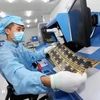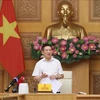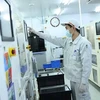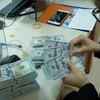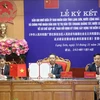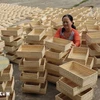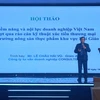Deputy Prime Minister Nguyen Xuan Phuc and his Lao counterpart Somsavath Lengsavath cut the ribbon to launch the “one-stop-shop” model at the Lao Bao (Quang Tri)-Densavan (Savannakhet) international border gate on February 6.
Previously, the border gate involved numerous steps, stages, and stops to cross, losing time and reducing efficiency. Within the new model, border officials from both nations will work together in one gate checkpoint, simplifying immigration and customs procedures.
This is the first time the model has been applied in a border gate along the East-West Economic Corridor as well as between the Greater Mekong Sub-region (GMS) and ASEAN countries.
Addressing the launching ceremony, Deputy PM Phuc said the application of the model is part of joint efforts between Vietnam and Laos to create a smooth business environment and increase border trade and investment between the two countries, contributing to the formation of an ASEAN Community by the end of this year.
He expressed his hope the model’s success will set an example for expansions to other international border gates across the East-West Economic Corridor and other important corridors in the GMS in general, realising the agreement to facilitate travel and the transport of goods across borders signed by the GMS states.
He continued to say he believes that the success of the model at the Lao Bao-Densavan international border gate will contribute to Laos ’ desire to become an inland bridge for Mekong regional countries.
At the same time, the model is expected to help Quang Tri and Sananakhet provinces utilise their role as bridgeheads of the two nations, maximising their potential and contributing to socio-economic growth of both localities.
Commenced in 2005 and piloted since January 5 of this year, the model is hoped to benefit import-export and entrance-exit activities, while contributing to increased transparency and decreased tax loss in State management of the gates.-VNA
Previously, the border gate involved numerous steps, stages, and stops to cross, losing time and reducing efficiency. Within the new model, border officials from both nations will work together in one gate checkpoint, simplifying immigration and customs procedures.
This is the first time the model has been applied in a border gate along the East-West Economic Corridor as well as between the Greater Mekong Sub-region (GMS) and ASEAN countries.
Addressing the launching ceremony, Deputy PM Phuc said the application of the model is part of joint efforts between Vietnam and Laos to create a smooth business environment and increase border trade and investment between the two countries, contributing to the formation of an ASEAN Community by the end of this year.
He expressed his hope the model’s success will set an example for expansions to other international border gates across the East-West Economic Corridor and other important corridors in the GMS in general, realising the agreement to facilitate travel and the transport of goods across borders signed by the GMS states.
He continued to say he believes that the success of the model at the Lao Bao-Densavan international border gate will contribute to Laos ’ desire to become an inland bridge for Mekong regional countries.
At the same time, the model is expected to help Quang Tri and Sananakhet provinces utilise their role as bridgeheads of the two nations, maximising their potential and contributing to socio-economic growth of both localities.
Commenced in 2005 and piloted since January 5 of this year, the model is hoped to benefit import-export and entrance-exit activities, while contributing to increased transparency and decreased tax loss in State management of the gates.-VNA
